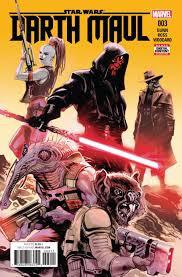It is interesting to note the apparent prominence of Darth Maul in the perceived hierarchy of important Star Wars characters: at least in terms of how early Maul has been afforded his own solo series (at Marvel, at least) compared to other characters.
We’ve had Princess Leia, Han Solo, Lando and possibly one or two others from Marvel in recent years, and there’s a Mace Windu series too.
But the reason I point this out is that Darth Maul is – in technical terms – such a minor character in the context of the Star Wars saga: he only appeared in one film, had virtually no dialogue, and in fact appeared in a total of three scenes and one epic fight sequence.
And yet he casts so big a shadow and is such a popular character that it isn’t actually surprising or maverick that Marvel and the Lucasfilm story group have given him his own limited series relatively early in their schedule.
There’s nothing particularly novel anymore about Darth Maul comics, as anyone who’s read any older, pre-Marvel/Disney Maul comic-book material will know.
And there’s not much new or revelatory here; but, even so, any dip back into the prequel era or the Maul mythology is inevitably interesting and moody. Any time I see Coruscant again or any prequel-era settings, I feel warm and fuzzy. More importantly, Darth Maul #1 gives us some good Maul/Sidious interplay and it shows us how antagonistic their relationship actually was.
Sidious treats Maul the same way we later see him treat Vader – as an underling or henchman, someone to be dominated and subjugated, virtually a slave.
It’s a good and natural stylistic choice to have these stories told primarily through Darth Maul’s inner thoughts. Darth Maul #1 gives us a good sense of Maul’s ruthlessness, his view of the Dark Side, and his restlessness – a restlessness and frustration that is key to why he is so driven and so full of energy and zeal by the time of The Phantom Menace.
As you’d expect in a Star Wars comic, there are also a few sweeteners and things thrown in too, such as Maul fighting some Rathtars. This first book also gives us a cute little mini-story (courtesy of Chris Eliopoulos and Jordie Bellaire) about one of Maul’s probe droids in Episode I.
Darth Maul #2 expands the story, throwing in more sweeteners (a visit to Nar Shadaah, a brief appearance by Episode I pit droids and, later, by a group of IG-88 type droids), and also making this narrative feel more like part of the Clone Wars arena by bringing in Cad Bane and Aurra Sing, which proves to be a great way of livening up the situation.
Having Sing and Bane involved, along with a couple of other lively characters, helps prevent this book becoming stuck in a one-note situation of moody or angry Maul.
We also continue to get a strong, palpable sense of the Sith mindset and ideology, the sense – from both Maul and Sidious – of the perceived injustice that was done to the Sith by the Jedi in the distant past, and also of Maul’s own inability to contain himself and his frustration at being held on a leash by his master.

The plot centers on Maul’s discovery of a Jedi Padawan being held prisoner and auctioned off as a slave. What’s interesting is Maul’s psychology: he wants to fight the Padawan, pit himself against her, but he considers his interest in her as “pure” and honourable, whereas he considers the corrupt, base motives of the all the others to be despicable.
Onto Darth Maul #3 and I feel like the Jedi Padawan, Eldra Kaitis, could’ve been made a more interesting character. She isn’t a bad character by any means – I just feel she could’ve had a bit more to her. That being said, she was designed from the outset to be a short-lived character, so maybe it didn’t matter too much.
Darth Maul #4 is more of the same, sustaining the quality level. We get much more interaction between Maul and Kaitis here, which is interesting.
I do wonder, at times, if exploring Maul too much somewhat undermines or lessens the mystique of the character we always loved from The Phantom Menace – but, given that most fans probably love reading this stuff, I know it’s a moot observation.
Wrapping up in Darth Maul #5, we center on the inevitable confrontation between the Sith and Jedi apprentices Maul and Kaitis. The fight itself is interesting, mostly due to Maul’s inner monologue.
Again, what we get a good sense of here is Maul’s primal need to fight and slay Jedi, which we know finds much fuller expression in the events of The Phantom Menace.
I like here that he comes to respect the Padawan – one of the interesting things in this story is his realisation that Kaitis could make a good Sith Apprentice: were it not for the fact that he has to kill her.
We also get some last bits of Aurra Sing and Cad Bane here, as well as an appropriately moody epilogue between Maul and Sidious on Coruscant.
All in all, this Darth Maul series has been an interesting and entertaining chapter slotted into the existing saga timeline.
There’s nothing revelatory here; but it does give us some good exploration of Maul’s psyche while offering a welcome slice of Clone-Wars-style storytelling.




